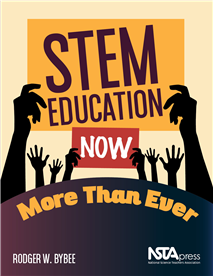A Much-Needed Roadmap for STEM Educators During Unconventional, Uncertain Times
By Carole Hayward
Posted on 2018-05-10
 Six-time NSTA author Rodger Bybee’s deep subject-matter expertise draws on 50 years of working in the science education field as well as keeping up with relevant STEM education-related publications, meetings, and projects. In the last few years, Bybee began noticing that far too many STEM initiatives seemed to suffer from the same shortcoming: They used the STEM acronym in broad, ambiguous ways.
Six-time NSTA author Rodger Bybee’s deep subject-matter expertise draws on 50 years of working in the science education field as well as keeping up with relevant STEM education-related publications, meetings, and projects. In the last few years, Bybee began noticing that far too many STEM initiatives seemed to suffer from the same shortcoming: They used the STEM acronym in broad, ambiguous ways.
STEM, Bybee said, had become just another slogan and lacked a clear definition and plan for policies, programs, and teaching practices.
Bybee’s latest book, STEM Education Now More Than Ever, presents ideas to counteract the weaknesses that the author sees in STEM education, an urgent call to action during a critical time in American history when the integrity of core STEM disciplines is under assault. He wants students to better understand the important place STEM education occupies across cultural, political, and ethical areas of their lives, especially as they prepare to become citizens of our democracy as well as the global community.
The book is organized into four thought-provoking sections that cover a wide range of issues:
The chapters organized under Part 1 (Innovations for STEM Education) make the new and urgent case for STEM education in light of the recent and seemingly growing challenges to science’s validity from the highest levels of government; discuss what STEM means for state policies, school curriculum, and classroom practices; cover how to connect STEM education with new state standards and the Next Generation Science Standards; and provide a plan of action to move STEM education from a collection of initiatives to a lasting component of American education.
“We need citizens who can entertain different, if not contradictory, ideas; understand different judgements; make decisions based on facts; and recognize the role of scientific evidence that supports that facts,” says Bybee. “Yes, civics education may address these aims, but STEM-related issues certainly could be the context for civil dialogue based on evidence and the recognition that scientific evidence is fundamentally different from personal opinions.”
Part 2 (Our Cultural Heritage: STEM and Society) canvasses America’s foundational ideas and values—the U.S. Constitution, democracy, citizenship—and connects them to each of the STEM disciplines. The chapters in this section help identify the components of a cultural foundation; how to establish a cultural foundation; and how to build on a cultural foundation via democracy, schooling, and STEM education.
“One of the unique goals of education is to aid the individual’s search for a personal freedom that results from the choices one makes and the values one develops as a citizen,” Bybee writes. “STEM education must contribute to the development of literacy and the priorities of this period in American history.”
Part 3 (Advancing STEM Education: Priorities, Perspectives, and Plans) focuses on the important purposes of STEM education and gives recommendations for how to translate those purposes into practical improvement—across STEM programs, STEM units, and professional learning and development. Teachers will appreciate Bybee’s suggestions for newer, faster ways to develop the most relevant STEM classroom learning.
“If we need STEM education now more than ever, what must be done?” Bybee asks. “The answer begins with designing and developing STEM units that will be implemented in current classrooms. Furthermore, it is essential that units are developed by classroom teachers with the provision of professional learning experiences.”
Part 4, the book’s concluding section, answers questions raised in previous chapters, such as: “How does STEM education represent an innovation?”; What is STEM trying to achieve?”; and “How long will it take to implement STEM programs?” This section also stresses the critical need for STEM educators to step up and be strong leaders during a time when far too many policy initiatives disregard rational, evidence-based information.
“Providing a vison for America’s future requires continued efforts to develop and apply the best that science, technology, engineering and mathematics have to offer,” Bybee says. “The health of our oceans, pollutants in the atmosphere, emerging and re-emerging infectious diseases, and environmental hazards are STEM problems that citizens must be able to recognize and use scientific information—instead of political and economic ideas—to solve.”
Read the free sample chapter, “Designing Innovative STEM Units,” to learn about the strategy that state and local leaders can use to design, develop and implement STEM units as well as the critical connection between the development of instructional materials and the professional learning of STEM teachers.
This book is also available as an e-book.
The mission of NSTA is to promote excellence and innovation in science teaching and learning for all.
Follow NSTA
Disclaimer: The views expressed in this blog post are those of the author(s) and do not necessarily reflect the official position of the National Science Teaching Association (NSTA).


